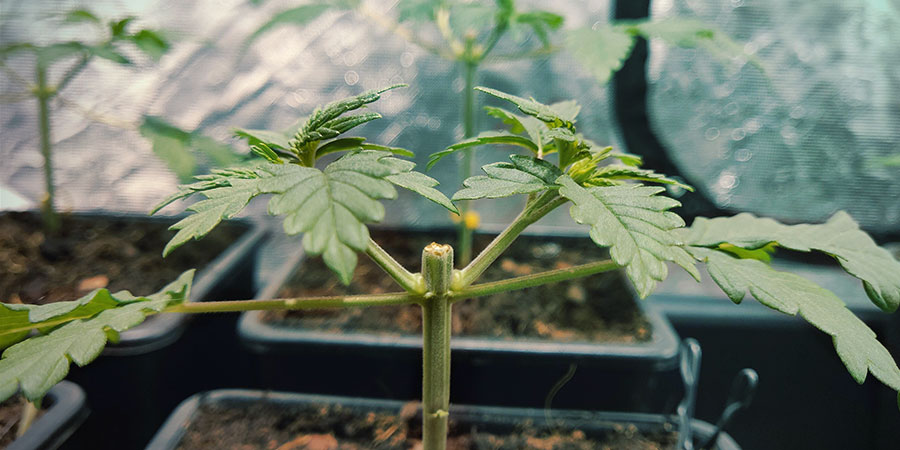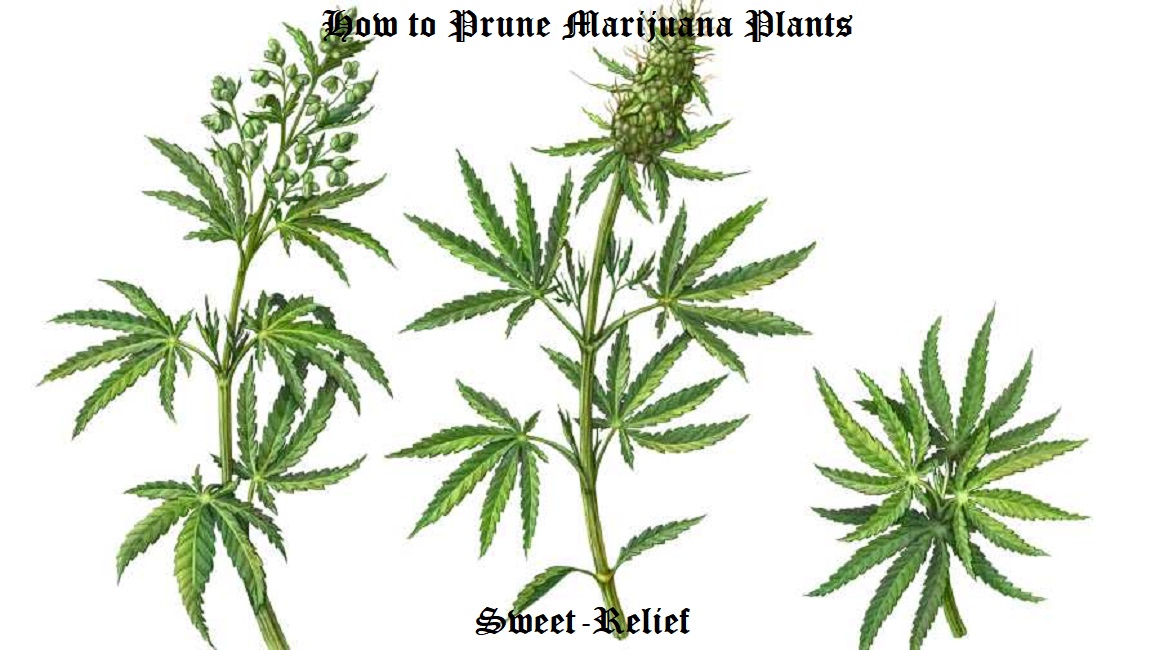When and how to prune marijuana plants: depending on why you want to prune your plants, you’ll need to do it one way or another, or at a certain time or another. You wouldn’t prune the same way if you want to make a parent plant, then if you wanted your plant to have a more distributed production in order to have a more discreet plant or if it’s just the way that that particular variety is grown.
We’re going to talk about a few different pruning situations, along with a picture and an explanation so that you know where you have to cut depending on the result you want, because not all pruning is done the same or for the same reason, so each type has a different effect on your plants.
Where to cut if you want to get a clone:
To do this, you need to make sure that the part of the plant that you want to use as a cutting is above where you’re cutting, and that there are a few small branches on it. You also need to leave a knot above the spot where you cut so that when you plant it again you can plant it deep up to the knot, because that’s where the roots will be coming out of. You’ll need to cut it just like the picture, take off the little branch from the knot where we’ll be burying our plant, make sure that you cut it at a 45º angle, and then you should put it straight into some rock wool, jiffy, or whatever you prefer. After a few days, following the right steps, your plant should have some roots.
Where to cut with the FIM pruning method:
The FIM prune is a type of cut that’s not followed through on, and it produces 4 or 5 new sprouds. At the beginning they may seem strange and deformed, but they’ll soon turn into sturdy branches, you just need to give them time. This kind of technique is perfect if you want to turn a cutting from another plant into a parent plant. Using the FIM method, you can get a lot of new branches on your plant, which will cause new slip sprouts to appear on the upper layers, which is what you’re after. The first time I tried this I got very good results even though I had never done it before, even though it might seem difficult, you just need to try and leave the middle tip when the cutting is still small, like in the picture, taking away about 60% of the tip and leaving the little leaves that were starting to come out. If you want, you can repeat the process when the tip begins to come out again. You’ll end up having an extremely dense parent plant, which’ll be extremely productive, meaning you can have a SCROG set up with a mesh in your grow room or grow tent.
You can find out about Super Silver Haze here.
Where to cut to grow two central calyxes:
To get two central calyxes and have a more centered harvest, all you need to do is cut above the two branches that we want to let grow. The cut must happen after a point in which two new branches are appearing, leaving about 1cm of trunk after those two branches. In the picture we can see the two sprouts coming out of the trunk, and even a little extra bit. In a couple of days the wound will close and the two new central points will have your plants entire attention. That’s where the most bud will be concentrated because your plant will see the two new branches as the central eye of the plant.
Vegetative Stage

The first stage of growth for any plant is the vegetative stage, when all the plant’s energy and biological intensity are telling it to reach a certain size. If the factors above are met, and the watering system operates well and is programmed correctly, growers can prune their plants for maximum yield during this vegetative period.
Proper pruning will help augment your marijuana plants’ natural growth. With careful cutting, you can help your plants send their energy to the places where it is most needed.
Best of all, pruning costs little or nothing. All you will have to do is invest a little of your time. For many folks, pruning is fun as well as rewarding. Spending a little quality time with your plants and making some judicious cuts can be a win-win. You will also need to get high-quality pruning clippers if you don’t already have them.
Keep in mind that all plants have a “game plan” for how they will grow from seed to flower. A week before pruning and a few days after, ease off fertilizing your plants so you don’t shock them and force them to produce bigger and more leaves right away. A seven-to-10-day period around pruning time will allow them to adjust and then continue a robust growth cycle.
Getting Better Bud
Most growers know the most significant flowers (buds) will grow when sun exposure and airflow are optimal. Knowing that, it makes perfect sense to start your pruning at the lower branches of the plant.
Begin at the innermost part of each lower branch, where buds may form but will never get large or dense. This pruning technique will send the message to the plant to give all its attention to the outermost buds. The inner leaves that get very small amounts of sunlight are expendable and should be picked off, helping marijuana plants use all of the available nutrients for producing the heaviest, tastiest and most potent harvest, regardless of whether it’s grown for medicinal or recreational purposes.
If you’re pruning because you’re planting in a very windy area or you simply don’t want your neighbors or others to see the plants, you might want to keep the height of your plants low. Pinch off the tallest main stalks with a very sharp pair of pruners. Go down the branch two to four bracts (about one or two feet) and make a clean cut.
You can even prune the outside branches of the ganja plant to give it an even look. If you are planting in a Screen (or Sea of Green) of Green, where you train the mass of plants to grow up through a wire or plastic grid that would be supported three or four feet above the ground for support, the same principles and methods of pruning apply.
Use Proper Pruners
By using the best, cleanest and sharpest pruners (I recommend Felco or Fiskars brands) for cutting lower interior branches, you’ll end up with a clean cut with very little chance of introducing disease. When snipping off lower interior leaves, using pruning snips or fine scissors is preferable.
Leaves are where sun-induced photosynthesis takes place and where nutrients are stored. Be careful not to take off all the leaves you plan to remove at one time. Focusing on the lowest branches and the interior of the plant or leaves that shade the buds, make it a two-part process. Each step should be a week apart.
Leave most of the largest fan leaves on the plant. They are the plant’s fuel factory. Removing yellowing, fading leaves and ones that shade the buds only. Keep in mind that while you are pruning, you should always be trying to eliminate the chance of shocking the plant, which may trigger early flowering that might result in lower yield.
Post-Pruning Plant Care

Finally, water your garden after pruning or de-leafing to stimulate growth and avoid shock. Giving your plants a dose of Vitamin B complex fertilizer along with the water will help them through this beneficial but often shocking period. The roots will benefit from this nutrient, and the plants should be higher-yielding. This vitamin fertilizer is thought to help the plants grow larger and produce bigger, more resinous colas.
In the flowering stage, growers feed their plants an organic high-phosphorous fertilizer. Vitamin B1 helps your plants take up and assimilate phosphorous. Kelp and other plants from the sea are a natural and organic source of vitamin B.
Carefully pruning your cannabis will help you maximize the growth and potency of every plant. This is just one of the many important factors to be aware of when growing nature’s gift, ganja. Seed (variety), site selection, soil and a regulated irrigation and fertilizing schedule are the other factors that can help you pull off a harvest you can be proud of.
A little extra care and time spent pruning can pay big dividends in a big, high-quality crop. Just ask any dedicated gardeners or growers, and they will tell you about the dedication and nurturing required and the ultimate payoff. You can do it!
